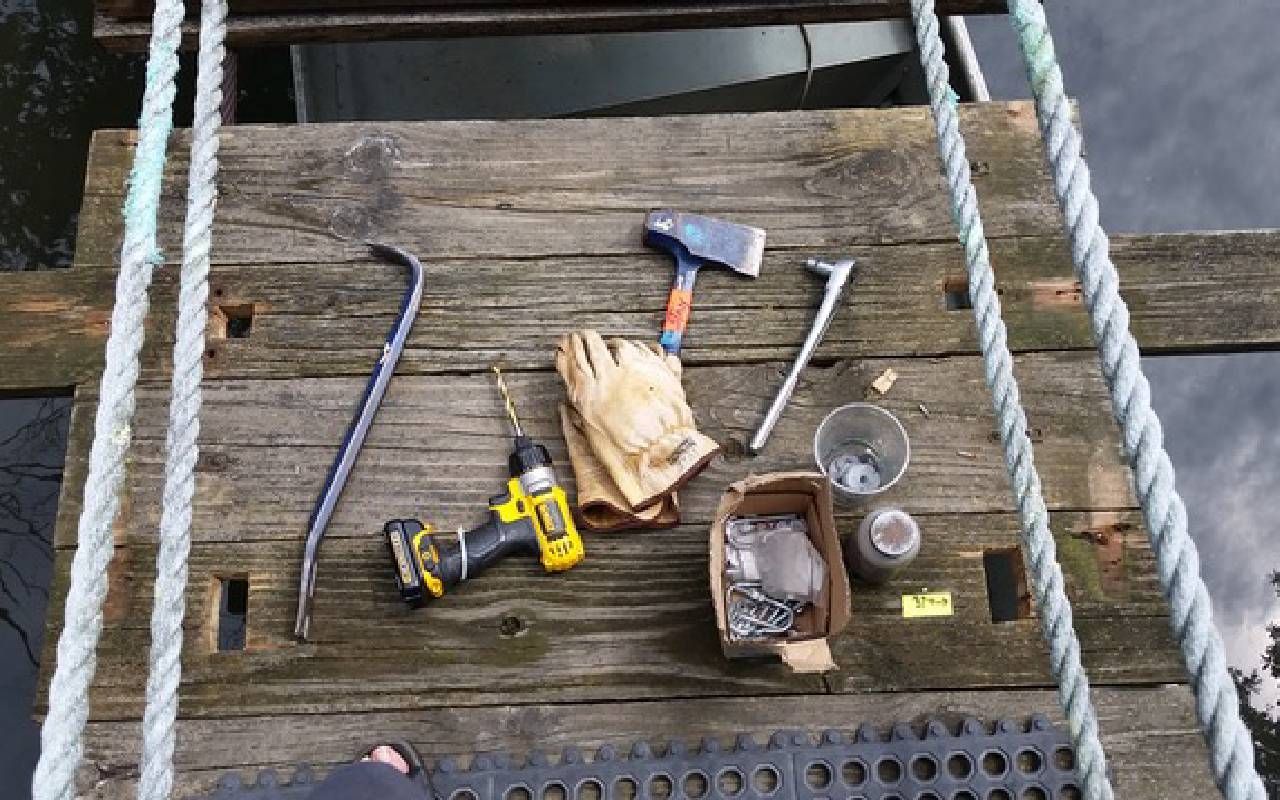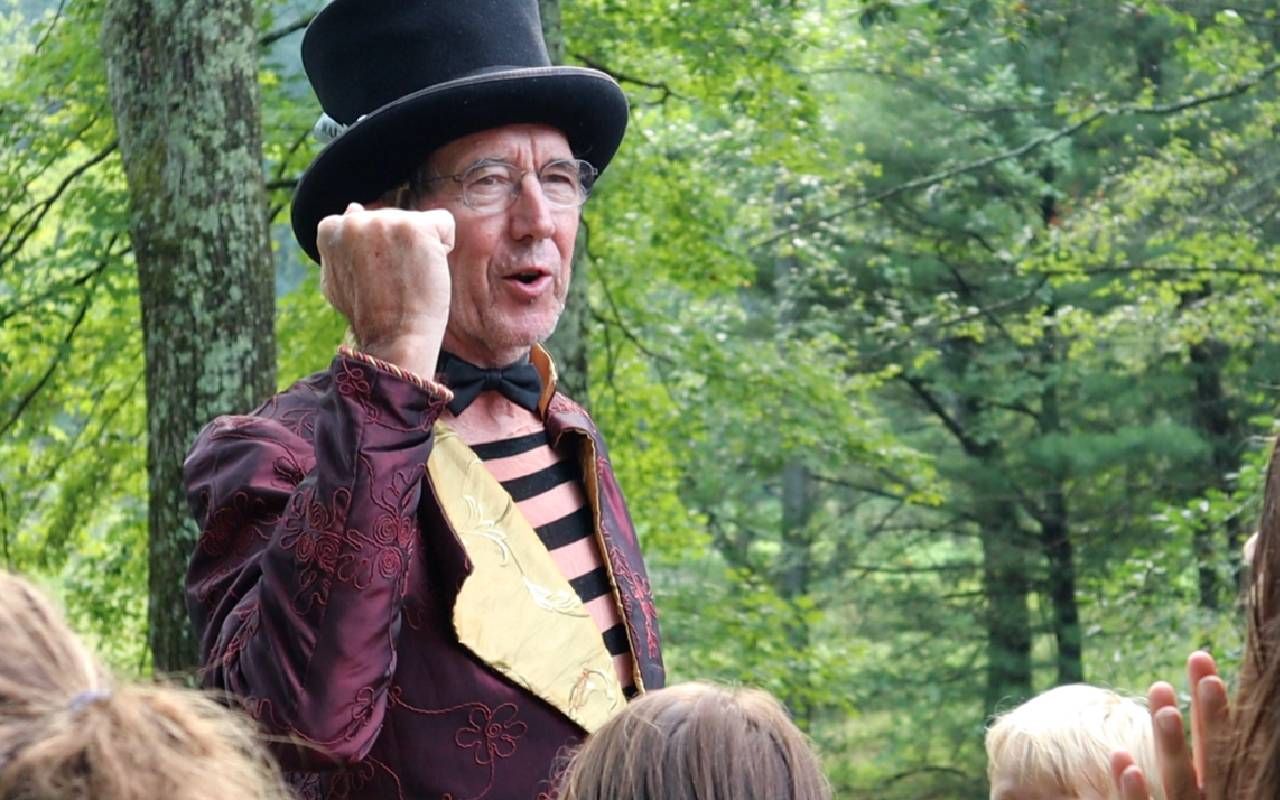If I Had a Hammer
When you pick up a tool, you animate it with your energy and intention. Working on the bridge became proof that in the aftermath of emotional discord, self-renewal was possible.
It's a Sunday afternoon in 1977 and my 10-year old self is with my father in the basement helping with a repair project. Blue Maxwell House coffee cans line the wall, filled with useful metal bits and a hurricane glass sits next to its kerosene base on a bookshelf.
We stand next to the furnace that rumbles now and then, our heads bent over the open jaws of the vise. My father demonstrates how to twiddle the handle to push the opposing blocks of metal closer and closer to the piece of wood, pressing it snug.

"Hand me a nail." he says. I hand him a nail. "Hand me the hammer." I hand him the hammer. The afternoon proceeds in this manner, serious and scripted. Did I ever ask to use the hammer myself? Did he ever offer? I can't be sure. I'd like to give him that possibility. Maybe I wasn't that interested in hammers or nails. I just wanted to be there with my dad, doing something simple and right.
Did I ever ask to use the hammer myself? Did he ever offer? I can't be sure.
Years later, as a frugal feminist, my tool-deprivation and secondary role irked me. Why was it that all the guys took 'shop' in middle school and I took 'home-ec?' Why was it that I saw myself only in the helper and cleaner-upper role on those Sunday basement afternoons?
Here I was paying people to fix my stuff. And I was outsourcing joy — earned by problem-solving and fixing with my own wits and hands.
A Light Bulb Went Off
In my early 50s all that ended along with my marriage when I had to replace a recessed light. "I can do that," I thought. I took the bulb to the hardware store and found its twin. At home, no matter how many YouTube videos I watched, the new bulb would not fit.
A catty voice in my head said: "How long does it take a divorced woman to change a lightbulb...?" A different voice countered, "What would you say to a friend?" and answered, "Go to the hardware store and ask the experts."
My local ACE hardware is a mix of country store and bougie boutique. Antique baseball bats line the walls and I covet their $26 art-deco nightlights. Within 5 seconds of entering you'll hear: "Can I help you find something m'am?" At the key counter I found Johnny ("How can I help you?"), a Midwestern gentleman with rimless spectacles and a kindly, curious nature.
I told him my story and asked, "Do you know how to fix this?" He said, "No, I don't. But I bet together we can figure it out."
Years of expecting expertise in others and denying my own responsibility and power dissolved with Johnny's words. We inspected the metal collar; we gazed at the bulb. My hands discovered that if I held the collar base and squeezed the pins on the side and he put the bulb in, the satisfying click happened. A design flaw! Only larger hands could do both tasks at once.
Meeting a Patient and Kind Teacher
Soon after, I lucked into a patient and kind teacher in the world of fixing and making. We met at a local dance. His top hat, bespoke patterned coat, gray cargo shorts and white knee-high shrimper's boots caught my eye. I asked, as we danced (he mysteriously graceful in his rubber boots) "Are you an artist?" He gazed distantly and said, "It's more complicated than that."

Over tea the next day he said he works summers at various dance and family camps; one in the Catskills where he is rebuilding a suspended bridge. Would I like to join him for a week of music, dancing and bridge-repair? A day later, after googling the heck out of him, I said, why yes, yes I would.
He picked me up in his Honda Odyssey, the back seats removed, the floor a collage of carpet remnants, coils of thick rope, hacksaw blades, socket wrenches, drift punches, a level; though at the time I didn't know their names. At night he threw down faded cushions from his 1968 VW bus, fell asleep and snored. I lay there at the rest-stop and listened to the hum of 18-wheelers idling nearby and in the glare of the lights wondered and smiled at what I was doing with my "one wild and precious life."
Getting to Work
On that first morning at camp we approached a red shed in a green field where a few sheep nibbled nonchalantly. I envied their ease. I dreaded the first impression as the only woman in the shop with the young guys in their day-glo T-shirts and Timberland boots. The hard-rock oldies on the radio and the scent of sawdust felt familiar.
The guys were sunny and more interested in their show-and-tell and jokey ribbing than in me. My friend put me to work in the shelter of a 1956 Rockwell drill press with a simple task: drill holes in the stanchions that would hold the hand-ropes.
A soothing rhythm developed as my fingers set the plastic ratchet clamps to hold the wood and slowly lowered the drill bit as wood particles flurried away. The repetition relaxed and satisfied. I could focus on one thing. That thing was do-able. It didn't involve complex emotions or unpredictable scenarios. It wasn't gendered or hard or something held by a priesthood.

Soon the movement of clamp to wood, metal bit to wood became one graceful action. My fingertips found a spiky edge where the drill bit broke through. For every problem there was a tool to solve it —hello, Shinto wood rasp! I enjoyed the rasp's toothy grasp on the wood and smoothing effect. "We're not making furniture here," my teacher chided.
As on all bridges in folk tales, I wrestled. My impatient desire to prove a point to myself and resentment of gendered expertise conflicted with the slow pace and the fact I was a novice with a guy who knew more than I did. And like most work, it wasn't all exciting power-tool wielding action. There were simple repetitive tasks, like gooping anti-seize paste onto every bolt on the bridge, or tying clove hitches over and over.
I returned to humility and gratitude. Given the major shifts in my life, where else would I rather be than here, being of use, on a wiggly cable bridge looking out over a clear pond with mist rising off of it and a thick margin of wild green in the distance?
Building Connections
Like the nursery rhyme "This is the House that Jack Built" I understood that every part of what I was doing held a future human relationship. If the stanchion can't be built, then the hand-rope won't support the children's hands. If the children's hands won't be supported, they can't cross the bridge. If the children can't cross the bridge, the connection between the old camp and the new camp will be lost; the bridge will exist only in memory.
When you pick up a tool, you animate it with your energy and your intention. My mentor said, "People say, "Man, I can knock that out in an hour! Your volunteer is gonna take 6 hours to put those rivets in." And I say, "yeah, but when she walks by those rivets later, she's gonna feel they're hers."
In that moment I felt that in fixing material objects, the world is made well in some small way, and something inside is fixed too.
That light in my kitchen became a symbol of my ability to take care of myself and to collaborate with others. It sparked a belief in my ability to problem-solve and use tools. Working on the bridge became proof that in the aftermath of emotional discord and weariness, self-renewal was possible.
For the first time in 10 years, the "wiggly bridge" of camp lore came to life. My mad hatter showed up in magenta Alice-in-Wonderland leggings, a burgundy brocade coat and his signature top hat. He lined up the children, "Youngest to oldest! Two by two!" between pips of his whistle.
The children's hands held the guide-ropes I had pulled through the stanchions. Their hesitant steps became confident as they giggled at the bridge's bounce and sway. My teacher merrily tapped planks of the bridge with his black umbrella as he led the parade.
I leaned against a tree and watched as the children and mothers crossed the bridge, serenaded by fiddles, guitars and song. In that moment I felt that in fixing material objects, the world is made well in some small way, and something inside is fixed too.


